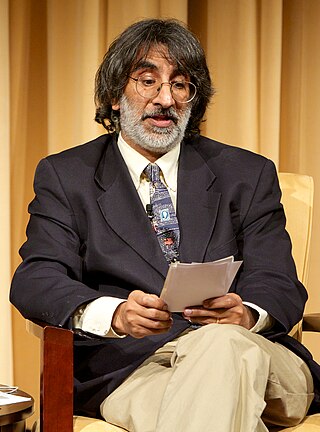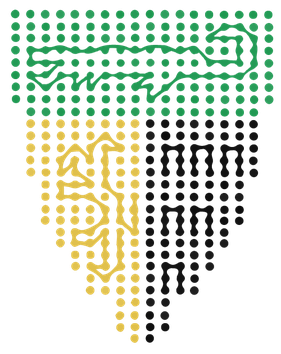Marbury v. Madison, 5 U.S. 137 (1803), was a landmark decision of the U.S. Supreme Court that established the principle of judicial review, meaning that American courts have the power to strike down laws and statutes they find to violate the Constitution of the United States. Decided in 1803, Marbury is regarded as the single most important decision in American constitutional law. It established that the U.S. Constitution is actual law, not just a statement of political principles and ideals. It also helped define the boundary between the constitutionally separate executive and judicial branches of the federal government.
Dred Scott v. Sandford, 60 U.S. 393 (1857), was a landmark decision of the United States Supreme Court that held the U.S. Constitution did not extend American citizenship to people of black African descent, and therefore they could not enjoy the rights and privileges the Constitution conferred upon American citizens. The decision is widely considered the worst in the Supreme Court's history, being widely denounced for its overt racism, judicial activism, poor legal reasoning, and crucial role in the start of the American Civil War four years later. Legal scholar Bernard Schwartz said that it "stands first in any list of the worst Supreme Court decisions". A future chief justice, Charles Evans Hughes, called it the Court's "greatest self-inflicted wound".
Critical legal studies (CLS) is a school of critical theory that developed in the United States during the 1970s. CLS adherents claim that laws are devised to maintain the status quo of society and thereby codify its biases against marginalized groups.

Originalism is a legal theory that bases constitutional, judicial, and statutory interpretation of text on the original understanding at the time of its adoption. Proponents of the theory object to judicial activism and other interpretations related to a living constitution framework. Instead, originalists argue for democratic modifications of laws through the legislature or through constitutional amendment.

John Hart Ely was an American legal scholar. He was a professor of law at Yale Law School from 1968 to 1973, Harvard Law School from 1973 to 1982, Stanford Law School from 1982 to 1996, and at the University of Miami Law School from 1996 until his death. From 1982 until 1987, he was the 9th dean of Stanford Law School.

Akhil Reed Amar is an American legal scholar known for his expertise in U.S. constitutional law. He is the Sterling Professor of Law and Political Science at Yale University, where he is a leading scholar of originalism, the U.S. Bill of Rights, and criminal procedure.
Reva B. Siegel is the Nicholas deB. Katzenbach Professor of Law at Yale Law School. Siegel's writing draws on legal history to explore questions of law and inequality, and to analyze how courts interact with representative government and popular movements in interpreting the Constitution. She is currently writing on the role of social movement conflict in guiding constitutional change, addressing this question in recent articles on reproductive rights, originalism and the Second Amendment, the "de facto ERA," and the enforcement of Brown. Her publications include Processes of Constitutional Decisionmaking ; The Constitution in 2020 ; and Directions in Sexual Harassment Law. Professor Siegel received her B.A., M.Phil, and J.D. from Yale University, clerked for Judge Spottswood William Robinson III on the D.C. Circuit, and began teaching at the University of California at Berkeley. She is a member of the American Academy of Arts and Sciences, and is active in the American Society for Legal History, the Association of American Law Schools, the American Constitution Society, in the national organization and as faculty advisor of Yale's chapter. She was elected to the American Philosophical Society in 2018.
"The Constitution is not a suicide pact" is a phrase in American political and legal discourse. The phrase expresses the belief that constitutional restrictions on governmental power must be balanced against the need for survival of the state and its people. It is most often attributed to Abraham Lincoln, as a response to charges that he was violating the United States Constitution by suspending habeas corpus during the American Civil War. Although the phrase echoes statements made by Lincoln, and although versions of the sentiment have been advanced at various times in American history, the precise phrase "suicide pact" was first used in this context by Justice Robert H. Jackson in his dissenting opinion in Terminiello v. Chicago, a 1949 free speech case decided by the U.S. Supreme Court. The phrase also appears in the same context in Kennedy v. Mendoza-Martinez, a 1963 U.S. Supreme Court decision written by Justice Arthur Goldberg.

The Living Constitution, or judicial pragmatism, is the viewpoint that the U.S. constitution holds a dynamic meaning even if the document is not formally amended. The Constitution is said to develop alongside society's needs and provide a more malleable tool for governments. The idea is associated with views that contemporary society should be considered in the constitutional interpretation of phrases. The Constitution is referred to as the living law of the land as it is transformed according to necessities of the time and the situation. Some supporters of the living method of interpretation, such as professors Michael Kammen and Bruce Ackerman, refer to themselves as organicists.
Constitutional theory is an area of constitutional law that focuses on the underpinnings of constitutional government. It overlaps with legal theory, constitutionalism, philosophy of law and democratic theory. It is not limited by country or jurisdiction.
Balkinization is a legal blog focused on constitutional, First Amendment, and other civil liberties issues. The weblog was created on January 13, 2003 by Jack Balkin, a professor of U.S. constitutional law at Yale Law School.
The New York University Law Review is a bimonthly general law review covering legal scholarship in all areas, including legal theory and policy, environmental law, legal history, and international law. The journal was established in 1924 as a collaborative effort between law students and members of the local bar. Its first editor-in-chief was Paul D. Kaufman. Between 1924 and 1950, it was at various times known as the Annual Review of the Law School of New York University and the New York University Law Quarterly Review before obtaining its current name in 1950.

The Information Society Project (ISP) at Yale Law School is an intellectual center studying the implications of the Internet and new information technologies for law and society. The ISP was founded in 1997 by Jack Balkin, Knight Professor of Constitutional Law and the First Amendment at Yale Law School. Jack Balkin is the director of the ISP.
An infomediary works as a personal agent on behalf of consumers to help them take control over information gathered about them for use by marketers and advertisers. The concept of the infomediary was first suggested by former McKinsey consultant John Hagel III and former Harvard Business School professor Jeffrey Rayport in their article The Coming Battle for Customer Information. The concept was explored in greater depth in Hagel's book Net Worth: Shaping Markets When Customers Make the Rules.

Sanford Victor Levinson is an American legal scholar known for his writings on constitutional law. A professor at the University of Texas Law School, Levinson is notable for his criticism of the United States Constitution as well as excessive presidential power and has been widely quoted on such topics as the Second Amendment, gay marriage, nominations to the Supreme Court, and other legal issues. He has called for a Second Constitutional Convention of the United States.

Paul Brest is an American legal scholar who is a former president of the William and Flora Hewlett Foundation, and was dean of Stanford Law School. He is credited with coining the name originalism to describe a particular approach to interpreting the United States Constitution.

James E. Fleming is an American legal scholar who serves as the Paul J. Liacos Professor of Law at the Boston University School of Law. He is a scholar in standard constitutional theory and constitutional interpretation, with special attention to criticizing originalism and defending moral readings of the U.S. Constitution, developing a civic liberalism concerned with protecting rights and instilling civic virtues, and justifying rights to autonomy and equality as central to constitutional self-government.
An unconstitutional constitutional amendment is a concept in judicial review based on the idea that even a properly passed and properly ratified constitutional amendment, specifically one that is not explicitly prohibited by a constitution's text, can nevertheless be unconstitutional on substantive grounds—such as due to this amendment conflicting with some constitutional or even extra-constitutional norm, value, and/or principle. As Israeli legal academic Yaniv Roznai's 2017 book Unconstitutional Constitutional Amendments: The Limits of Amendment Powers demonstrates, the unconstitutional constitutional amendment doctrine has been adopted by various courts and legal scholars in various countries throughout history. While this doctrine has generally applied specifically to constitutional amendments, there have been moves and proposals to also apply this doctrine to original parts of a constitution.

Common good constitutionalism is a legal theory formulated by Harvard law professor Adrian Vermeule that asserts that "the central aim of the constitutional order is to promote good rule, not to 'protect liberty' as an end in itself". Vermeule describes it as an attempt to revive and develop the classical legal tradition by understanding enacted law as a positive application of background natural law principles. Within this tradition, he claims law is defined as "an ordinance of reason promulgated by political authorities for the common good." Vermeule states that law in this sense is "not tethered to particular written instruments of civil law or the will of the legislators who created them" but instead embody rational determinations of the common good, and it is those determinations, as well as the natural law background against which they are made, which constitute the law. Vermeule says that these principles include "a candid willingness to "legislate morality."
A. Michael Froomkin is the Laurie Silvers & Mitchell Rubenstein Distinguished Professor of Law at the University of Miami in Coral Gables, Florida. His work on technology law since the mid-1990s spans Internet governance and regulation, privacy, encryption, AI and medicine, drones, and robotics. In 2012, he co-founded the annual We Robot conference with Ian Kerr and Ryan Calo in order to think ahead about the challenges to law and policy that widespread use of robots will bring. He blogs at Discourse.net









